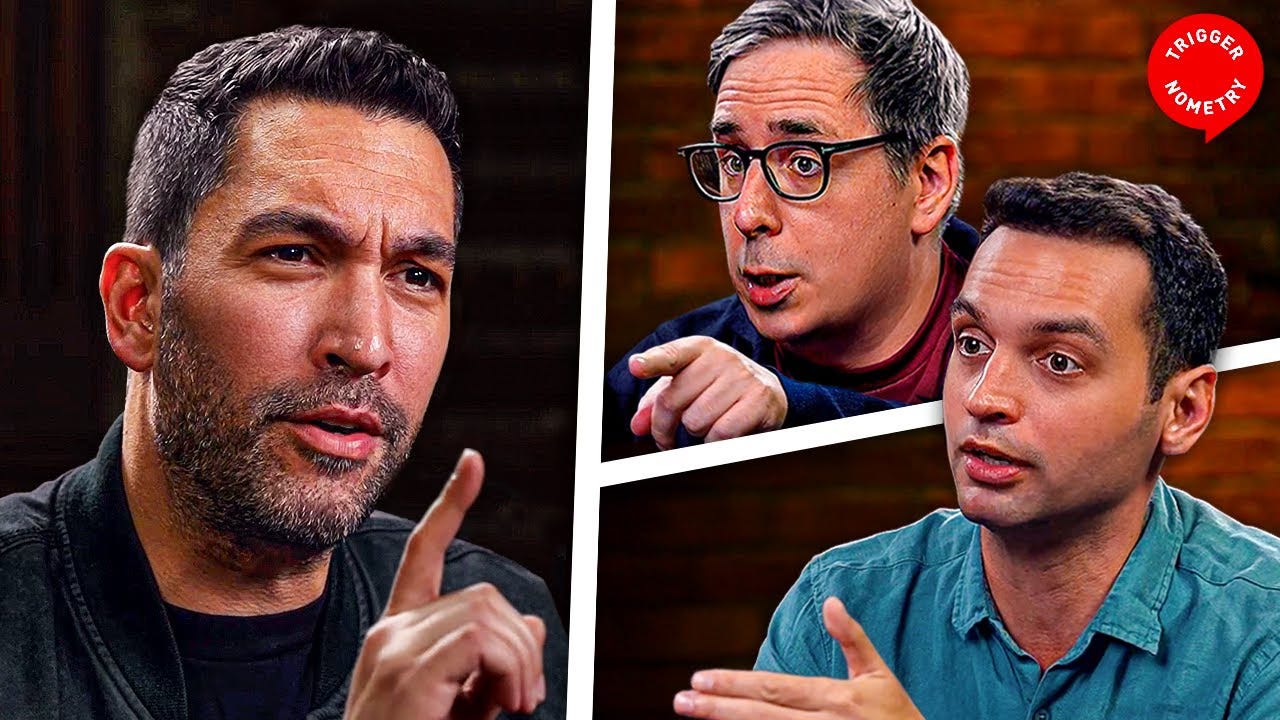Where Dave Smith Lost the Debate: A Forensic Breakdown of His Conversation With Konstantin
Why Dave’s moral framework couldn’t handle the realities Konstantin pressed him on.
When Dave Smith sat down with Konstantin from Trigonometry to discuss October 7th, Gaza, and Israel’s response, something unusual happened. For years, Dave has been able to dominate political conversations using a combination of moral clarity, libertarian framing, and verbal agility. He’s used to debating people who aren’t prepared — or who accept his premises without noticing.
This time, the structure of the debate didn’t favor him.
🎧 Audio Version (12 minutes)
For those who prefer listening.
Not because Konstantin was aggressive.
Not because the topic was emotional.
But because Dave’s worldview simply couldn’t carry the weight of the real-world complexity in front of him.
In this breakdown, I’ll walk through the exact points where the argument slipped away from him — and why.
1. Collapsing state and non-state actors into a single moral category
Dave’s initial framing treated Gaza as if it were:
a reservation,
under blockade,
holding a stateless population,
with resistance fighters acting out of desperation.
This fits naturally within a libertarian template:
state power = suspect, and non-state actors = reactive.
But this framing collapses the wrong categories. It treats a hybrid militant group with battalions, an intelligence network, engineering divisions, and tunnel infrastructure as though it were a loosely organized protest movement.
The moment Konstantin introduced scale and structure — tens of thousands of fighters, Iranian backing, fortified tunnel networks — Dave’s framework should have shifted.
It didn’t.
And that was the first structural crack.
2. The “police action” ideal died the moment reality entered
One of Dave’s core arguments was that the attack should have been handled through:
targeted assassinations,
special operations,
surveillance,
long-term intelligence pressure.
In principle, it sounds humane and precise.
But Konstantin asked the only question that matters:
How do you conduct a “police operation” against tens of thousands of armed fighters embedded inside civilian areas and tunnel systems?
Dave had no concrete answer.
He circled back to earlier decades of Israeli counterterror strategy — strategies built for small-cell terrorism, not for an entrenched, heavily armed underground army.
This was the first moment where Dave’s argument stopped functioning in contact with reality.
3. Treating outcomes as morally identical, regardless of intent or context
Dave relied on a familiar move he often uses effectively:
moral flattening.
He tried to frame civilian deaths caused by:
deliberate hostage-taking, torture, and execution
as essentially equivalent to
civilian deaths during military operations against embedded combatants.
This flattening works only when the audience is willing to ignore distinctions of intent, conduct, and doctrine.
Konstantin wasn’t.
He forced the moral categories back into focus:
deliberateness vs collateral
targeting vs shielding
initiation vs response
At that moment, Dave’s symmetry collapsed. His framework needed equal categories in order to stay upright — and this debate didn’t have equal categories.
4. Avoiding numbers because numbers break the premise
Throughout the discussion, Dave repeatedly said versions of:
“I don’t know the number.”
“Maybe 40,000? Maybe less?”
“I’m not sure.”
But the entire debate hinges on the scale, distribution, and entrenchment of Hamas fighters.
Numbers aren’t a minor detail.
Numbers dictate strategy.
The avoidance revealed something deeper:
Once the scale is admitted, the “police action” argument becomes impossible to defend.
Konstantin kept returning to the specifics Dave tried to step around — and each time he did, the gap in Dave’s model widened.
5. Wrong tool, wrong conflict: Libertarian templates applied to a hybrid insurgency
Dave’s worldview works powerfully when the conflict is:
state vs state,
protesters vs government,
conventional war,
domestic overreach,
or intelligence abuse.
It breaks when:
militants embed in hospitals and schools,
tunnels dictate operational choices,
civilians are used as shields,
hostage-taking shapes the timeline,
and a non-state actor behaves with the strategic depth of a state military.
This debate wasn’t about morality in the abstract.
It was about the mechanics of violence.
And Dave kept trying to solve a mechanical problem with a philosophical tool kit.
6. Konstantin pressed where Dave couldn’t pivot
Konstantin’s strength is clarity.
He sticks to:
definitions,
numbers,
boundaries,
real-world constraints,
and logical follow-through.
This forced the debate onto terrain where Dave’s agility couldn’t help him. Dave is excellent at reframing, softening, or broadening questions — but Konstantin didn’t give him room.
Each time Dave tried to generalize, Konstantin re-specified.
Each time Dave moralized, Konstantin operationalized.
And each time Dave dodged scale, Konstantin brought it back.
This steady pressure, applied calmly, is what made the argument slip out of Dave’s hands.
7. In the end, Dave defended the framework — not the situation
By the close of the conversation, Dave wasn’t defending a strategy, a timeline, or a practical alternative.
He was defending a worldview.
There’s a difference.
Konstantin kept returning to:
“What should have happened on October 8th?”
Dave never answered concretely.
And that’s where the debate ends:
not with emotion,
not with theatrics,
but with a structural failure to connect moral philosophy to operational reality.
Conclusion
Dave Smith is thoughtful, principled, and often compelling.
His critiques of state power are consistent and sincere.
But in this debate, his framework wasn’t built for the terrain he stepped onto. The moral lens he relies on simply couldn’t handle the scale, the logistics, or the nature of the threat Konstantin pressed him to confront.
Konstantin didn’t beat him.
Reality did.
And that’s why this conversation played out the way it did.

